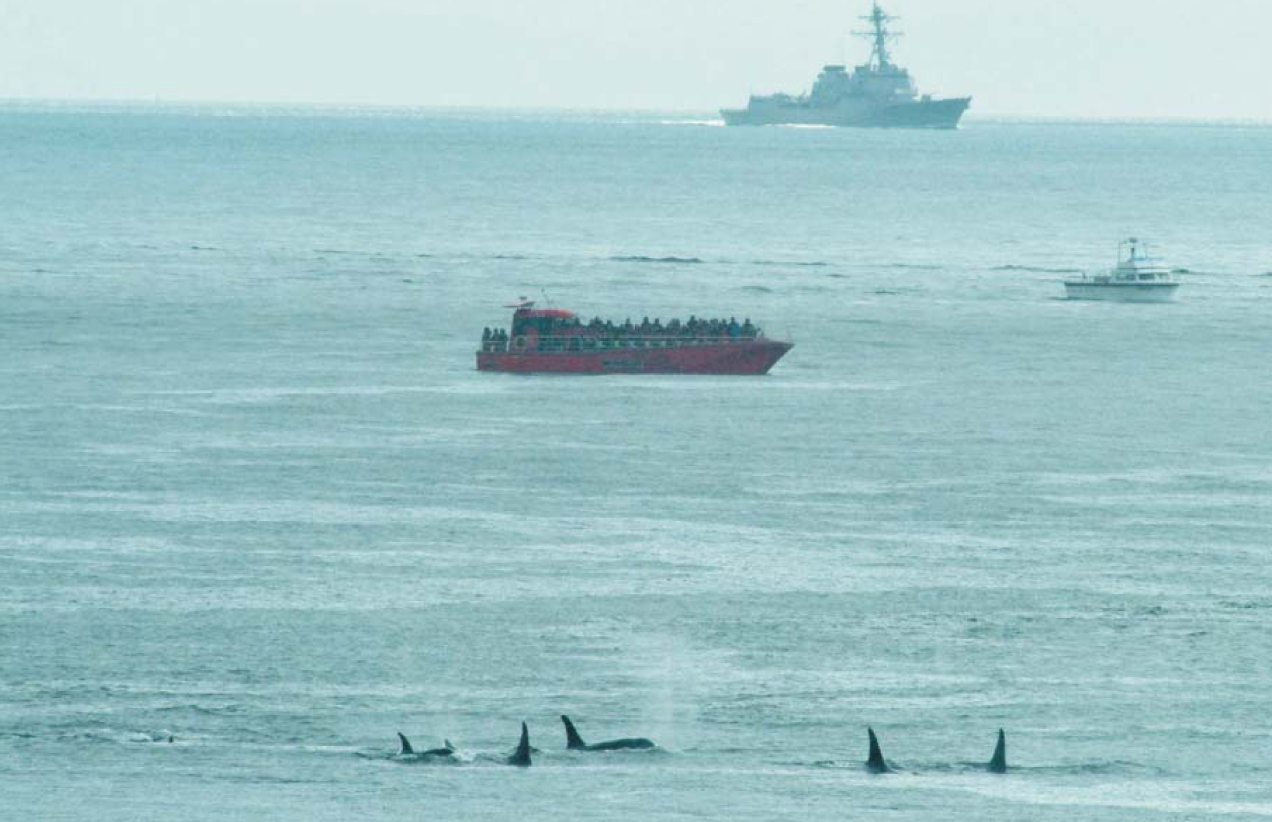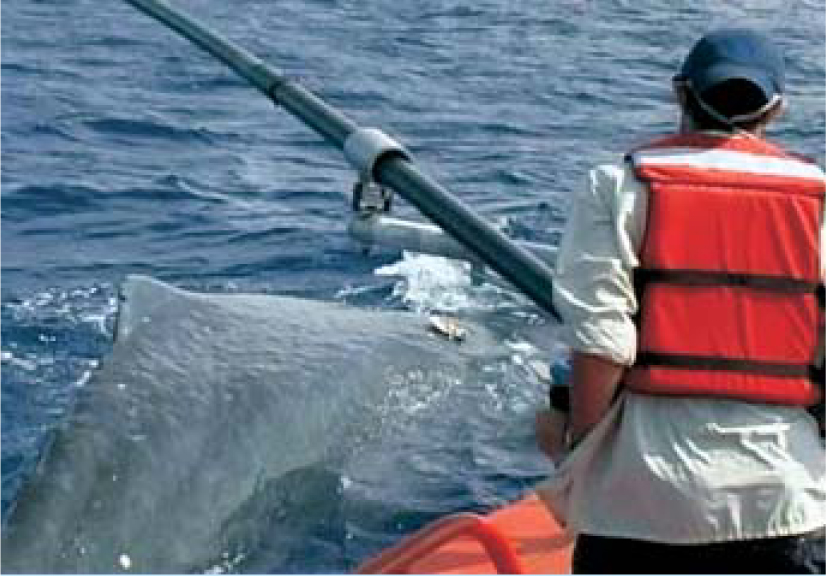Legal battle over sonar testing heats up
DOI: 10.1063/1.2883901
The ongoing battle between environmental groups and the US Navy over sonar testing and its potentially negative impact on marine life heated up in January with a flurry of legal activity and an intervention by President Bush. The latest developments began on 3 January when a federal judge with the US District Court for the Central District of California ruled that the navy must adhere to a series of strict mitigation measures in its planned mid-frequency (1–10 kHz) sonar training exercises off the California coast, calling the navy’s proposed mitigation scheme “grossly inadequate to protect marine mammals from debilitating levels of sonar exposure.”
On 15 January President Bush issued an order exempting the navy from meeting the provisions in two major environmental laws: the Coastal Zone Management Act and the National Environmental Policy Act. In a court filing, government lawyers claimed that the federal rule limiting sonar testing “profoundly interferes with the navy’s global management of US strategic forces, its ability to conduct warfare operations, and ultimately places the lives of American sailors and marines at risk.” In deference to the White House, US District Judge Florence-Marie Cooper temporarily set aside two of the toughest restrictions.
The lawsuit was filed in March 2007 by the Natural Resources Defense Council (NRDC). In August, Cooper issued a temporary restraining order against the navy, barring the use of sonar in training missions off the Southern California coast until the navy adopted better safe-guards to protect marine mammals that might be harmed by the exercises. The navy appealed that decision and won a short-lived reprieve, but on 13 November a US appeals court restored the ban.
However, the three-judge panel rejected the need for a broad absolute injunction and instructed Cooper to craft a “narrowly tailored” mitigation plan in accordance with existing environmental regulatory requirements. Cooper’s 3 January decision banned the use of sonar within 12 nautical miles of the California coastline and also expanded the “safety zone” from 915 meters to 2010 meters. The safety zone requires the navy to power down or turn off its sonar when marine animals come within that range. Under the new order issued on 17 January, the navy is exempt from the requirements to shut down sonar if a marine mammal comes within 2010 meters of a sonar device and to reduce power under specific sea conditions that would enable sonar pulses to propagate farther than usual. The 12-nautical-mile requirement remains intact, and the use of mid-frequency sonar in the Catalina Basin, which has a high density of marine mammals, is still banned entirely.
Also still in place are requirements for monitoring an area for 60 minutes prior to the onset of sonar-testing exercises to ensure no animals are present and for having two lookouts trained by the National Marine Fisheries Service to monitor the area during the exercises.
Taking it to the courts
The lawsuit is one of three major cases regarding sonar testing that have been filed by the NRDC in the past three years. In October 2005 the NRDC filed a broad lawsuit contending that the navy has conducted sonar-testing exercises in violation of several environmental laws; the outcome of that lawsuit is pending. In 2006 the navy agreed to expand its buffer zone for sonar exercises held off the coast of Hawaii in response to another NRDC lawsuit.
Although numerous legal issues are being argued in those cases, first and foremost is the question of whether national security interests trump environmental regulations, according to NRDC lawyer Joel Reynolds, who emphasizes that the intent of the lawsuits is not to halt sonar testing but to enforce stricter mitigation measures. “We have said from the beginning of this litigation that the navy can meet its training objectives while substantially increasing protections against unnecessary harm to whales and other marine mammals,” he said. In fact, says Reynolds, the additional limitations are similar to those already in use by the oil and gas exploration industry, which conducts seismic surveys to detect deposits beneath the ocean floor. “Individually, these measures are insufficient because they only address part of the problem,” he said. “But collectively, they can make a very real difference.”
The navy has adopted mid-frequency active sonar—initially developed to hunt for Soviet submarines in the deep ocean—as a technique in shallower coastal waters to train its sailors to detect the much quieter diesel–electric submarines used by more than 40 nations, including North Korea and Iran. The quieter subs cannot be detected with passive sonar techniques. In official statements the navy has argued that 29 safety procedures are already in place and Cooper’s additional restrictions would cripple the effectiveness of the planned training exercises. The decision also undermines the navy’s plans to establish a similar sonar-training range off the coast of North Carolina.
Reynolds deems the scientific evidence that sonar testing can be harmful to marine mammals “overwhelming,” but the scientists conducting research in that area are more circumspect in their assessments. “The fact that active sonar has an impact on whales has long been known,” says Chris Parsons, a George Mason University researcher who points out that whalers once used active sonar, a precursor of the mid-frequency sonar, to drive whales to the surface so they could be easily harpooned. However, researchers did not begin to connect active sonar with the mass strandings of whales until the mid-1990s. Even so, it was difficult to document a stranding event fully enough to rule out any other possible cause and draw a direct link to sonar.
That changed in March 2000; in the Bahamas, a navy sonar trial using transmitters in the mid-frequency range and operating at 223–235 decibels resulted in the beaching of 17 small whales called beaked whales, 7 of which died. Coincidentally, Kenneth Balkan, a marine biologist who had formerly performed acoustic research for the navy, lived nearby, and he was able to collect video footage, photographs, documentation, and even physical specimens from the dead whales. He sent the heads to the National Marine Fisheries Service, which performed necropsies and concluded that the dead whales had experienced acoustically induced hemorrhages around the ears and that the resulting disorientation may have led to the stranding. That is also evidence of decompression sickness, more commonly known as “the bends,” often experienced by scuba divers who resurface too rapidly.
The Bahamas stranding provided “the first incontrovertible evidence of whales dying from exposure to sonar,” says Reynolds. The navy does not dispute that finding and accepts fault for that incident in its official report. However, the navy also argued that it was an isolated event resulting from a rare confluence of conditions that do not apply to the sonar testing that lies at the heart of the ongoing lawsuits.
Even scientists who, like Parsons, strongly support the idea of the mid-range sonar’s detrimental effect caution that the causal relationship is not as clear-cut in other stranding events as it is for the 2000 Bahamas incident. Part of the problem is that the ocean environment contains a great deal of noise stemming from all kinds of sources: low-frequency rumbling from ship engines and propellers, seismic testing for oil and gas exploration, and sounds from the animals themselves. Even Reynolds concedes, “Acoustic trauma is extremely difficult to document.”
“Where there is consensus on sonar and beaked whales, it is that under certain circumstances not completely understood, mid-frequency naval sonar initiates a chain of behavioral and physiological responses that terminate in beaked whales stranding on beaches and then dying of hyperthermia,” says Douglas Wartzok, vice president for academic affairs at Florida International University. “There are many unknowns regarding the source operating characteristics, environmental features affecting the transmission of the sounds to the animals, and the behavioral and physiological responses of the whales.”
Fleshing out the science
Exactly how the sonar contributes to the symptoms observed in stranded animals remains unclear, with two prevailing hypotheses. One is that the acoustical properties of sonar cause nitrogen to leak out of the blood, which leads to the hemorrhaging observed in some beached specimens.
The other hypothesis is that the strandings are the result of a behavioral reaction in response to the sonar. Scuba divers, when resurfacing, practice a 5-meter safety stop for a couple of minutes before surfacing to guard against the bends. Beaked whales appear to adopt a similar strategy in their diving behavior; they make a series of increasingly shallow shorter stops before resurfacing completely.
Brandon Southall, director of the National Oceanic and Atmospheric Administration’s (NOAA’s) Ocean Acoustics Program, suggests that the sonar pings may trigger behavioral changes that affect the whales’ diving patterns in ways that secondarily harm them, such as nitrogen bubbling out of the blood. If it is a behavioral response, says Parsons, loud noises from nonsonar activities could also be contributing to the growing number of stranding events.
William Lang, program director for NSF’s division of ocean sciences, points out that the Office of Naval Research has an aggressive research program to study acoustic impacts on marine life and funds solid peer-reviewed science in conjunction with other federal agencies, including NSF. “The navy logically wants answers on sonar,” he said, “so the academic question becomes, if you look at manmade sound in the ocean as a concern, should sonar research predominate?” According to Lang, that question is being addressed by an interagency task force that is investigating not just sonar but all sources of manmade sound in the ocean environment.
In addition, Southall is the principal investigator for a major behavioral response study currently in progress, a collaboration between NOAA Fisheries, the navy, the Woods Hole Oceanographic Institution, and half a dozen academic institutions designed to measure the behavioral response of different cetaceans to mid-frequency sonar. The scientists are monitoring the behavior of the animals in situ with digital acoustic recording tags: sophisticated acoustic sensors (hydrophones) coupled with three-dimensional accelerometers and 6.6 gigabytes of memory, capable of recording audio, pitch, roll, heading, and depth in the ocean environment. Suction cups are mounted onto the devices, which are then attached to the animals using cantilevered carbon-fiber poles. Scientists can then observe how the animals behave in their natural environment. The tags are recovered after recording is complete, and the data is transferred to a computer for analysis.
Lang concedes that “strandings of relatively low numbers of marine mammals, predominantly beaked whales, are correlated with naval exercises, and sonar is considered the most likely cause of the strandings,” even though the precise mechanisms are not yet fully understood, and not all navy exercises result in strandings.
“Nobody is denying that there have been mass strandings of marine mammals related to, and probably caused by, navy sonar,” says Southall, noting that the symptoms of certain types of lesions and hemorrhages observed in stranded animals do appear to be unique to the presence of military sonar. But he stops short of deeming the correlation a certainty. “There are several areas where we are missing key information, such as exactly how sound affects the behavior of these animals, and whether those effects are biologically significant,” he said. “We’re still very much in the infancy of this research.”

Whales swimming near the USS Shoup (in the background) as it conducted sonar exercises in the San Juan Islands off the Washington coast in May 2003.
KENNETH C. BALCOMB III, CENTER FOR WHALE RESEARCH


Tagging of a sperm whale during a 2003 field study in the Gulf of Mexico by the Woods Hole Oceanographic Institution.
(From a WHOI video by Patrick Miller, University of St. Andrews.)

